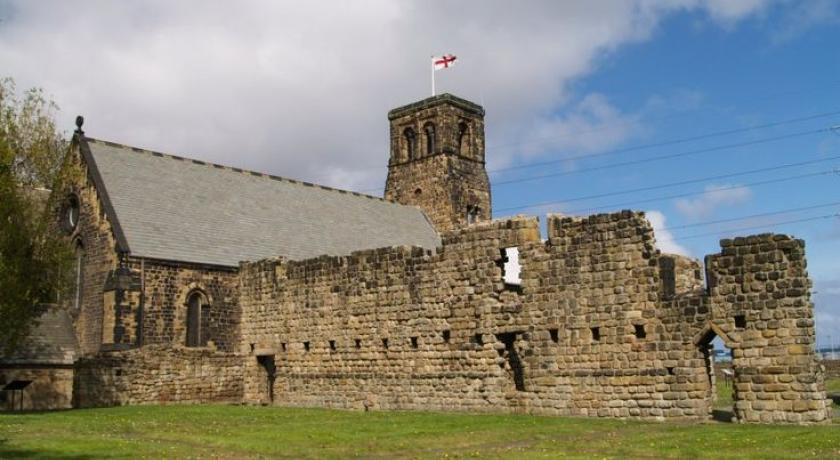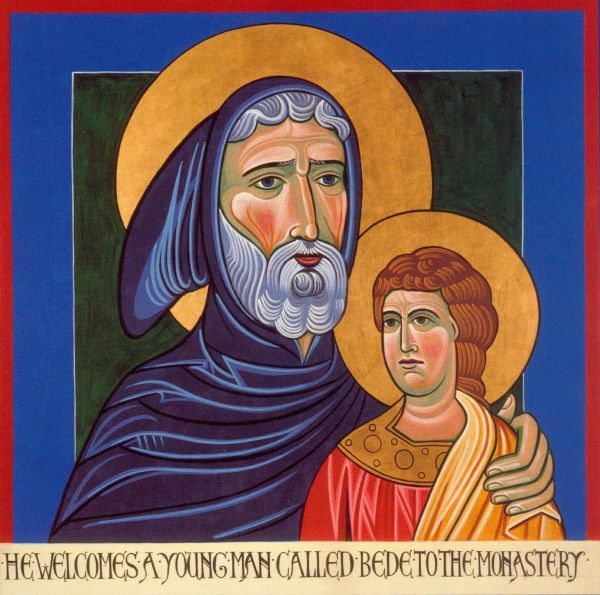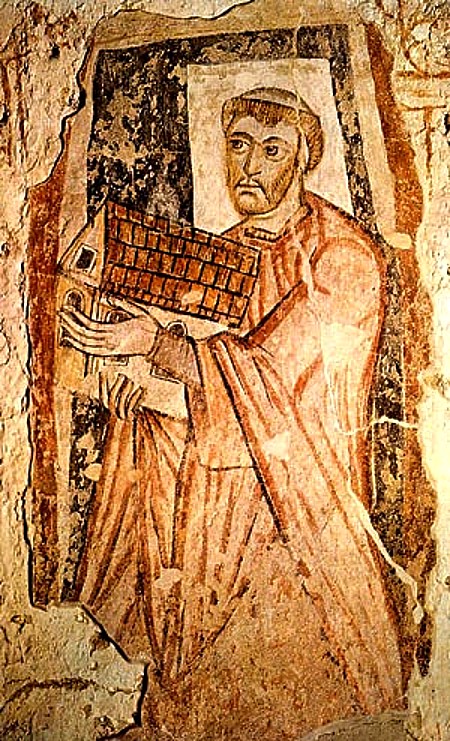Saint of the Day – 12 January – St Benedict Biscop OSB (c 628-690) (pronounced “bishop”) – Bishop and Abbot of Wearmouth, who introduced Stained Glass windows to England and raised the Venerable Saint Bede, Founder of Monkwearmouth-Jarrow Priory (where he also founded the famous library) – he was known as a Bibliophile, Confessor, a man of great piety and learning. Born in c 628 in Northumbria, England as Benet Biscop and died on 12 January 690 of natural causes at Wearmouth, England. Patronages – English Benedictines, musicians, painters, Church libraries and librarians, Sunderland, England, St Benet Biscop Catholic Academy in Northumberland, England.
Benedict’s idea was to build a model Monastery for England, sharing his knowledge of the experience of the Church in Europe. It was the first Ecclesiastical building in Britain to be built in stone and the use of glass was a novelty for many in 7th-century England. It eventually possessed, what was a very large library for the time – several hundred volumes – and it was here, that Benedict’s student St Bede wrote his famous works. The library became world-famous and manuscripts that had been copied there became prized possessions throughout Europe, including especially the Codex Amiatinus, the earliest surviving manuscript of the complete Bible in the Latin Vulgate version.
Benet was born of the highest Anglo-Saxon nobility. He held office in the household of King Oswy (Oswiu) of Northumbria. But, after a journey to Rome, the first of his five such trips, when his was 25 (653) in the company of Saint Wilfrid, the saint renounced his inheritance and dedicated himself to God. He then spent his time in studying the Scriptures and prayer. Following a second visit to Rome with Oswy’s son Aldfrith in 666, he became a Monk in the Monastery of Saint-Honorat in Lerins near Cannes, France, taking the name Benedict. He remained there for two years strictly observing the rule.
His third pilgrimage to Rome in 669, coincided with the visit of Archbishop-elect Wighard of Canterbury, who died there, prior to his consecration. Saint Theodore was finally selected to replace Wighard as Archbishop of Canterbury and Pope Saint Vitalian, ordered Benedict to accompany Theodore and Saint Adrian to England, as a Missionary, which he did in obedience. Theodore appointed Benedict Abbot of Sts Peter and Paul (now St Augustine’s) Monastery in Canterbury, where he remained for two years before returning to Northumbria. (He was succeeded as Abbot by Saint Adrian, whose feast day was yesterday and who held this position for 39 years.)
Thereafter, Saint Benedict travelled to and fro between Britain and Rome (beginning in 671), returning always with books and relics and bringing back with him craftsmen to build and enrich the Churches of Britain. This fourth journey was made, with the view of perfecting himself in the rules and practice of a monastic life, so he stayed a while in Rome and visited other Monasteries.
In 674, he was granted 70 hides of land by Oswy’s son, Egfrid, at the mouth of the river Wear (Wearmouth), where he built a great stone Church and Monastery dedicated to Saint Peter. He was the first to introduce glass into England, which he brought from France along with stone and other materials. His foreign masons, glaziers and carpenters taught their skill to the Anglo-Saxons. He spared no trouble or effort in seeking far and wide for all that would richly embellish his Romanesque church.

From his trip to Rome in 679, Benedict brought back Abbot John of Saint Martin’s, the precentor (Archcantor) from Saint Peter’s. This was a result of Benedict persuading Pope Saint Agatho that Abbot John would be able to instruct the English monks, so that the music and ceremonies at Wearmouth might follow exactly the Roman pattern. Upon his return to England, he held training classes in the use and practice of church music, liturgy and chants. (John also taught the English monks uncial script and wrote instructions on the Roman liturgy for them.)
But, chiefly, he brought books, for he was a passionate collector. His ambition was to establish a great library in his Wearmouth Monastery. He also imported pictures from Rome and Vienne, beautiful paintings and musical scores. Among these treasures imported from Rome were a series of paintings of Gospels scenes, of Our Lady and the Apostles and of incidents described in the Book of Revelation, to be set up in the church.
Benedict also devised his rule based on that of Saint Benedict and those of the 17 Monasteries he had visited. He doubtlessly organised the scriptorium in which was written the manuscript of the Bible which, his successor as Prior at Wearmouth, Saint Ceolfrid, took with him in 716 as a present to Pope Saint Gregory II – the very book was identified in the Biblioteca Laurentiana at Florence in 1887, the famous Codex Amiatinus. All this immeasurably enriched the early English Church.
Because his Monastery and Church at Wearmouth was so edifying, in 682 Egfrid gave him a further gift of forty hides of land, this time at Jarrow on the Tyne River. Here he established a second Monastery, six miles from St. Peter’s and dedicated it to Saint Paul (now called Jarrow) in 685, which became famous as a great centre of learning in the West and the home of Saint Bede. our Saint’s charge and spiritual son. Among its inmates were many Saxon thanes turned Monks, who ploughed and winnowed and worked at the forge, like the rest and at night, slept in the common dormitory, for rank and class had no place among them.
And because Benedict was busier than ever with all his enterprises and still governed both Abbeys, he handed over some of his authority. Benedict first took to help him at Wearmouth, his nephew, Saint Eosterwin, a noble like himself and then Saint Sigfrid. In Jarrow, he placed Saint Ceolfrid in charge. While Benedict still ruled the Abbeys as their Founder, he made these men the Abbots under his direction of the two foundations, so that the Monasteries would not be without leadership during his absences.
Benedict made his last voyage to Rome in 685, returning with even more books and sacred images and some fine silk cloaks of exceptional workmanship, which he exchanged with the King for three hides of land.
It was due to Benedict Biscop that so much material lay to hand for Bede and other scholars and that, a solid foundation was laid for the later glories of the English Church. After his death, the school at Jarrow alone, comprised 600 scholars, apart from the flow of constant visitors. It was also in large part due to him, that the Church of Northumbria turned from the old Celtic forms, to those of Rome. Out of his labours and travels came a rich and abundant harvest.
At the end of his life, Benedict suffered from a painful paralysis in his lower limbs. (It is interesting to note that Sigfrid was afflicted with the same paralysis about the same time.) Throughout his three-year confinement, he asked the Monks to come into his room to sing Psalms and he joined them when he could. His last exhortations to his Monks, before he died at age 62, were to continue his work, to preserve his great library, to follow the monastic Rule of Saint Benedict and, to elect an Abbot, based on his holiness and ability rather than his lineage. He said, he would rather the Monasteries be turned into wildernesses than to have his brother succeed him as Abbot.
Benedict’s biography was written by Saint Bede, who had been entrusted to his care at age seven and whose learning was made possible by the library Benedict collected at Jarrow. Bede, the historian, says that the civilisation and learning of the 8th century rested in the Monastery founded by Benedict.
Proof of a very early public cultus of Benedict Biscop comes from a sermon of Bede on him (Homily 17) for his feast but the cultus became more widespread only after the translation of his relics under Saint Ethelwold about 980. Saint Benedict’s relics are thought to rest at Thorney Abbey, although Glastonbury also claims some of them.
Below is a link to St Bede’s Life of Benedict Biscop from his Lives of the Abbots of Wearmouth and Jarrow written c. 716:
http://www.fordham.edu/halsall/basis/bede-jarrow.html
And a link to an explanation of:
The Codex Amiatinus:
http://www.knight.org/advent/cathen/04081a.htm






4 thoughts on “Saint of the Day – 12 January – St Benedict Biscop OSB (c 628-690)”